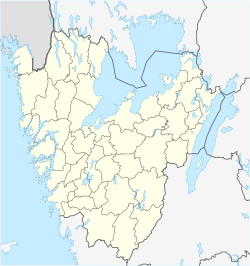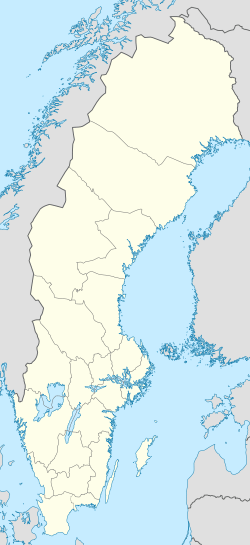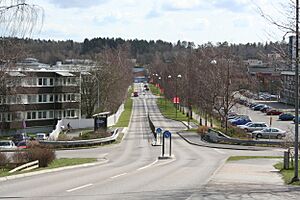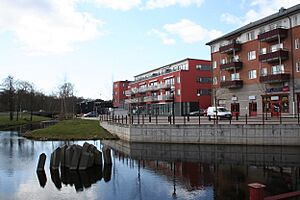Mölnlycke facts for kids
Quick facts for kids
Mölnlycke
|
|
|---|---|

Central Mölnlycke
|
|
| Country | Sweden |
| Province | Västergötland |
| County | Västra Götaland County |
| Municipality | Härryda Municipality and Mölndal Municipality |
| Area | |
| • Total | 8.10 km2 (3.13 sq mi) |
| Population
(31 December 2020)
|
|
| • Total | 18,392 |
| • Density | 2,270.6/km2 (5,881/sq mi) |
| Time zone | UTC+1 (CET) |
| • Summer (DST) | UTC+2 (CEST) |
Mölnlycke is a small town in Sweden. It is very close to Greater Gothenburg, which is a larger city. Mölnlycke is the main town of Härryda Municipality in Västra Götaland County.
In 2019, about 17,499 people lived here. The town actually stretches across two different municipalities. Most of it is in Härryda Municipality, but a small part is also in Mölndal Municipality.
Contents
Mölnlycke's Past: A Look at Its History
Early Settlers and Ancient Times
The first people came to the Mölnlycke area a very long time ago. This was during the Stone Age, when people used tools made of stone. At that time, there were five separate lakes here. Today, these lakes have joined together to form one big lake.
Many old things from the Stone Age have been found near the lake shore. Scientists think that when people learned how to farm, they moved away. They probably went to areas that were better for growing crops.
Mölnlycke in the Middle Ages
People settled here again during the Middle Ages. This is when the first Råda Church was built in the area. During the Middle Ages, the border between Denmark and Sweden ran right through Mölnlycke. This meant the area was often affected by wars between the two countries.
How Mölnlycke Got Its Name
The name Mölnlycke was first written down in 1576. The name comes from two old Swedish words: "mölna" and "lycka". "Mölna" means "mill" and "lycka" means "field". So, Mölnlycke literally means "mill field".
This name probably came from a mill. A mill was built in the Middle Ages where the Mölnlycke Fabriker building stands today.
The Textile Factory and Railway
In 1849, a man named Gustaf Ferdinand Hennig started a company. It was called Mölnlycke Väfveri AB, and it made textiles (like cloth and fabric). This factory had a huge impact on the town.
It brought many workers to Mölnlycke. It also led to the building of a railway line. This railway connected Gothenburg and Borås. Today, the railway still has a stop in Mölnlycke. The company is now known as Mölnlycke Health Care.
Mölnlycke's Location: Geography
Mölnlycke is located about 91 meters (or 298 feet) above sea level. It is only about 10 kilometers (or 6 miles) away from Gothenburg. Gothenburg is the second largest city in Sweden.
Being so close to Gothenburg helped Mölnlycke grow quickly. This growth started in the 1900s. Many people began to live in Mölnlycke and travel to Gothenburg for work. This is called commuting.
Mölnlycke's Culture: What to Do
The Mölnlycke Kulturhus is a special building in the center of town. "Kulturhus" means "Culture House" in Swedish. It is a place where people can enjoy different activities.
Inside the Kulturhus, you will find:
- The Mölnlycke library, where you can borrow books.
- A cinema, where you can watch movies.
- A café, where you can relax and have a snack.
See also
 In Spanish: Mölnlycke para niños
In Spanish: Mölnlycke para niños





